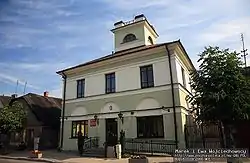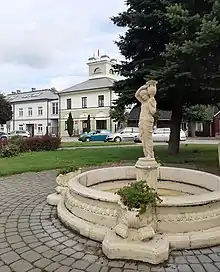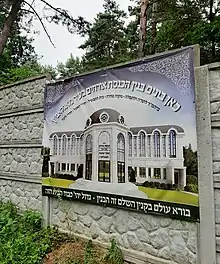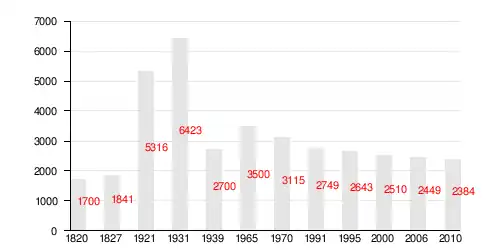Mogielnica
Mogielnica [mɔɡʲɛlˈɲit͡sa] is a town in Grójec County in Masovian Voivodeship, Poland, with 2,475 inhabitants (2004) and an area of 141.56 square kilometres (54.7 sq mi). It is the seat of Gmina Mogielnica (urban-rural gmina administrative unit). In other languages, it is referred to as Mogelnitsa, Mogelnitse, Mogelnitza and/or Mogielnicy.
Mogielnica | |
|---|---|
 Town hall | |
 Coat of arms | |
 Mogielnica | |
| Coordinates: 51°41′23″N 20°43′23″E | |
| Country | |
| Voivodeship | Masovian |
| County | Grójec |
| Gmina | Mogielnica |
| Established | 1249 |
| Town rights | 1317 |
| Government | |
| • Mayor | Sławomir Chmielewski |
| Area | |
| • Total | 12.98 km2 (5.01 sq mi) |
| Population (2006) | |
| • Total | 2,461 |
| • Density | 190/km2 (490/sq mi) |
| Time zone | UTC+1 (CET) |
| • Summer (DST) | UTC+2 (CEST) |
| Postal code | 05-640 |
| Area code | +48 48 |
| Car plates | WGR |
| Website | http://www.mogielnica.pl |
Modern history


In World War I, the Tsarist regime, in reprisal for its own catastrophic failures in battle with Germany, expelled the Jews of Mogielnica. The Jewish paper, Haynt, published in Congress Poland, stated in its May 23, 1915 issue (under Russian military censorship): "The entire Jewish population was deported from Mogielnica, roughly 5,000 people. They were given a short period of time in which to liquidate their businesses."[1] Some of the Jews returned to Mogielnica once Poland re-emerged as a sovereign state.
World War II
In 1940, during the Nazi Occupation of Poland, German authorities established a ghetto in Mogielnica to confine, persecute and exploit its Jewish population.[2][3][4] The ghetto was demolished on February 28, 1942, when its 1,500 inhabitants were transported in cattle trucks to the Warsaw Ghetto, the largest in all of Nazi-occupied Europe, with over 400,000 Jews crowded into an area of 1.3 square miles (3.4 km2). From there, most victims were sent to the Treblinka extermination camp.[5][6][7][8] The Nazis demolished the 18th-century Jewish cemetery located on the left side of the road to Grójec, near Przylesie Street, and used its headstones for pavement. A monument now stands in its place.
Historical population of Mogielnica

Notes and references
- Chaim Finkelstein (2007). "Haynt: The First World War Years". Today: A Jewish Newspaper, 1908-1939 (Haynt: a Tsaytung bay Yidn,1908-1939) Chapter Three. Administered by Bob Becker. pp. 61–62. Archived from the original on July 16, 2011. Retrieved July 31, 2011.
- "Cmentarz żydowski w Mogielnicy (Jewish cemetery in Mogielnica)," at Kirkuty.xip.pl.
- The statistical data compiled on the basis of "Glossary of 2,077 Jewish towns in Poland" Archived 2016-02-08 at the Wayback Machine by Virtual Shtetl Museum of the History of the Polish Jews (in English), as well as "Getta Żydowskie," by Gedeon, (in Polish) and "Ghetto List" by Michael Peters at www.deathcamps.org/occupation/ghettolist.htm (in English). Accessed July 12, 2011.
- "The War Against The Jews." The Holocaust Chronicle, 2009. Chicago, Il. Accessed June 21, 2011.
- Warsaw Ghetto, United States Holocaust Memorial Museum (USHMM), Washington, D.C.
- Richard C. Lukas, Out of the Inferno: Poles Remember the Holocaust, University Press of Kentucky 1989 - 201 pages. Page 13; also in Richard C. Lukas, The Forgotten Holocaust: The Poles Under German Occupation, 1939-1944, University Press of Kentucky, 1986, Google Print, p.13.
- Gunnar S. Paulsson, "The Rescue of Jews by Non-Jews in Nazi-Occupied Poland," Journal of Holocaust Education, Vol.7, Nos.1&2, 1998, pp.19-44. Published by Frank Cass, London.
- Edward Victor, "Ghettos and Other Jewish Communities." Archived 2011-06-08 at the Wayback Machine Judaica Philatelic. Accessed June 20, 2011.
External links
![]() Media related to Mogielnica at Wikimedia Commons
Media related to Mogielnica at Wikimedia Commons
- Mogielnica official website. (in Polish)
- Mogielnica Family Research Group
- Jewish Community in Mogielnica on Virtual Shtetl